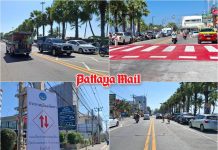National budget appropriators have allocated only 1 percent of the requested 13.5 billion baht for a 10-year project to transform Pattaya into a special “greenovative tourism” zone for sustainable development.
At a Jan. 17 Pattaya City Council meeting, Mayor Itthiphol Kunplome announced that the Budget Bureau approved 135 million baht for first-year “pilot” projects detailed in the Designated Areas for Sustainable Tourism Administration master plan approved in August. Seventeen of 132 proposed projects will begin this year, although completion will require additional funding.
Among the projects funded this year are design and studies into a bio-gas generation plant, closed-circuit television camera installation on Koh Larn, research into marine conservation on Koh Larn and design studies into tunnels under the intersections of Sukhumvit Road and North, Central, South and Thepprasit roads.
Funding also will cover projects in other sub-districts, such as research into living conditions of Thai-Muslims in Pong, drainage pipe installation in Nongprue and Huay Yai, planning of a Mabprachan Reservoir-area park, design studies for a beach-activities area at Baan Amphur Beach in Najomtien, planning of a public park in Takientia, expansion of water supply systems in Sai Mab Wa-Pattaya Park Hill and Sai Rong Po-Khao Maikaew, a Wat Nong Ket Yai folk museum in Nong Plai Lai, digging of a reservoir in Khao Maikaew and a research study into locally made products there.
Set up by a 2003 royal decree, DASTA was given a mission to integrate and oversee tourism development in areas designated to have superb natural environments, cultural and traditional importance and have been developed for tourism purposes. Among the first projects approved were Koh Chang National Park, the Chiang Mai Night Safari, Koh Lanta, Koh Samet and the Nongteng-Chakkarat forest in Nakhon Ratchasima.
With its sprawling nighttime industry and many environmental problems, Pattaya’s bids for DASTA status – and the millions in baht that come with it for mayoral pet projects – were repeatedly turned away. But in July 2008 Bangkok officials conceded, admitting Pattaya formed a “distinctive” area for international tourism and could retain its status as a draw for foreign currency if developed properly.
Thus began more than three years of discussions and proposals that culminated in 29 public hearings and private meetings and the March 2009 designation of a 928 sq. km. zone comprising Pattaya and the eight districts.
Politicians submitted nearly 15 billion baht in proposals. DASTA initially approved 34 of those for the first year, but national budgeters cut that to just 17 and whether Pattaya politicos can talk their way into the other 99 percent of the funds they want remains to be seen.




